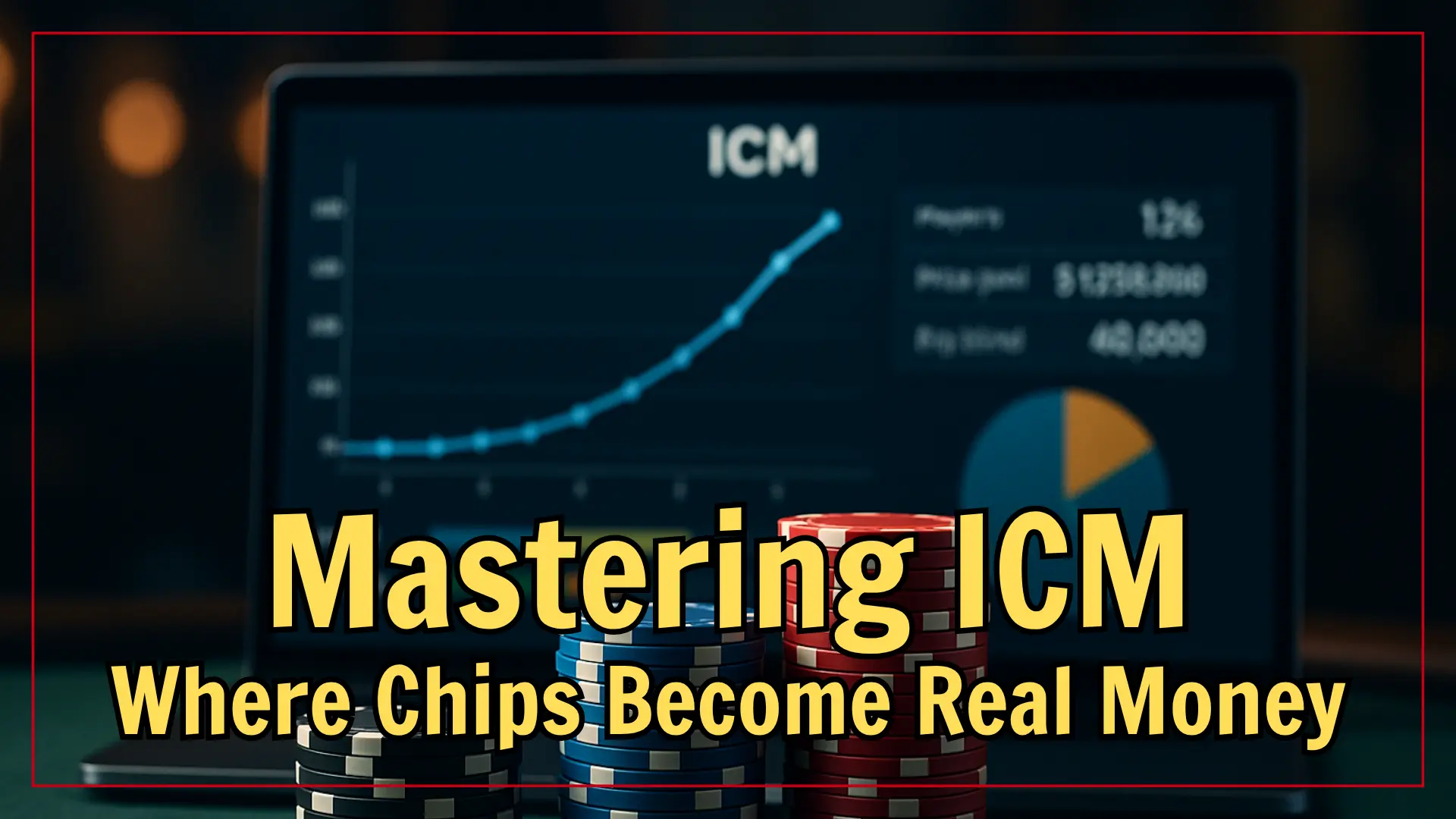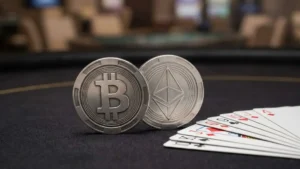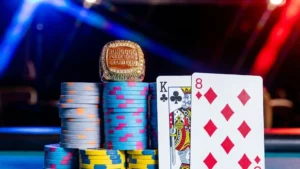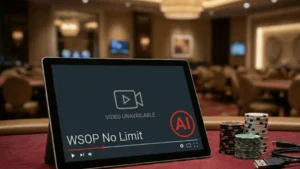Ready to boost your tournament winnings?
Listen to the PokerOffer audio guide to ICM and learn exactly how to convert your chip stack into real prize money.
Introduction: Beyond the Chip Count
Imagine this: you are at the final table of a major poker tournament. The chip leader, a notoriously aggressive player, shoves all-in. You look down at Ace-Queen. In a cash game, it is an easy call. But here, with massive pay jumps on the line, your tournament life hanging in the balance, and a short stack about to be blinded out, is it still the right play? This single decision could be worth tens of thousands of dollars. The answer lies not in your chip stack, but in a concept that separates amateurs from professionals: the Independent Chip Model (ICM).
Introduced to the poker world by Mason Malmuth in 1987, the Independent Chip Model is a mathematical model that has become the cornerstone of modern tournament strategy. It is a vital tool with a unique purpose: to translate your tournament chip stack into a concrete monetary value. This guide provides a complete roadmap to understanding and mastering ICM. It will deconstruct the theory, walk through practical calculations, and provide actionable strategies that will fundamentally improve your decision-making process and, ultimately, your long-term profitability in poker tournaments.
Section 1: What is the Independent Chip Model (ICM)? The Core Principle of Tournament Poker
Defining ICM: The Bridge Between Chips and Cash
The Independent Chip Model (ICM) is a calculation that converts a player’s tournament chip stack into its real-money value, often referred to as “tournament equity”. It achieves this by using the current stack sizes of all remaining players and the tournament’s payout structure to calculate the probability of each player finishing in each paid position (1st, 2nd, 3rd, etc.).
This concept is exclusive to tournaments. In cash games, chips have a fixed, linear value; $500 in chips is worth exactly $500. In tournaments, this direct relationship does not exist. Understanding ICM provides the true monetary value of your chips at any given moment, which is essential for accurate risk-reward analysis.
The Golden Rule: Chips Are Not Money and Value Is Not Linear
The most critical concept in tournament poker is that the value of chips is non-linear. This principle forms the foundation of all ICM strategy.
A simple example illustrates this perfectly:
- In a $10 Sit & Go, you start with 1,000 chips, and those chips are worth $10.
- If you survive into the money, guaranteeing a $20 prize while still holding 1,000 chips, those same chips are now worth at least $20.
- If you win the entire tournament for a $50 prize, you will hold all 10,000 chips, meaning each 1,000-chip increment is now worth only $5.
The chip count remains identical at each stage — yet its monetary value fluctuates dramatically throughout the tournament.
The Principle of Diminishing Returns
The reason for this non-linear value is the principle of diminishing returns.
- The first chip you acquire is the most valuable because it keeps you in the game.
- Every subsequent chip you win is worth slightly less than the one before it.
Therefore, a fundamental rule emerges: doubling your stack never doubles your real-money equity.
For example:
- In a 9-man Sit & Go, a player who doubles their stack from 1,500 to 3,000 chips does not double their tournament equity.
- Their equity might increase from 11.1% to only 20.3% — an 83% gain, not 100%.
- Later in the same tournament, doubling up might only increase equity by 53%, or even as little as 42%.
This principle dictates that preserving your stack is often more important than aggressively trying to grow it.
Chip EV vs. $EV: The Most Important Decision Filter
This is where theory becomes practice. Every tournament decision must be filtered through two lenses: Chip Expected Value (cEV) and Monetary Expected Value ($EV).
- Chip Expected Value (cEV):
The average number of chips you expect to win or lose from a play. This is the primary consideration in cash games. - Monetary Expected Value ($EV): The average amount of real money you expect to win or lose. This is what truly matters in a tournament, and it is directly calculated by ICM.
Because the value of chips is non-linear, some plays can be profitable in chips (+cEV) but disastrously unprofitable in real money (−$EV). A coin flip for your tournament life might be a break-even cEV play, yet it is almost always a heavily −$EV play due to the principle of diminishing returns. In an early all-in situation, you might risk your entire $10 buy-in for a potential gain of only $6.67 in tournament equity.
This creates a fundamental conflict in tournament poker. Players are often conditioned to pursue chip accumulation — a cEV mindset — while optimal strategy demands equity preservation — a $EV mindset. Most players learn poker with a simple goal: to get more chips. This builds an instinct to take any seemingly profitable edge. ICM introduces the payout structure as a critical variable that challenges this instinct, revealing that the potential $EV loss from busting is almost always greater than the $EV gain from doubling up. The true power of ICM lies in its ability to apply logical, mathematical discipline to override a player’s natural, chip-focused intuition.
Section 2: The Mechanics of ICM: How Your Stack Gets Its Value
The Calculation Concept
ICM does not predict who will win based on skill. It operates on a simple premise: a player’s probability of finishing in 1st place is equal to their share of the total chips in play. To calculate the probability of finishing in 2nd, 3rd, and so on, the model simulates every possible 1st place outcome. For example, to find Player A’s chance of finishing 2nd, it first calculates the probability of Player B winning, then calculates Player A’s chance of winning the “new” tournament among the remaining players. It repeats this for every other player winning and sums the weighted probabilities.
Finally, the model multiplies the probability of finishing in each position by the prize money for that position to arrive at a player’s total tournament equity ($EV).
A Practical Example: The 3-Player Calculation Unpacked
To demystify the process, consider a detailed 3-player calculation.
- Scenario: 3 players remain. Payouts: 1st = $7, 2nd = $3, 3rd = $0.
- Stacks: Player A = 5 chips (50%), Player B = 3 chips (30%), Player C = 2 chips (20%). Total chips = 10.
Step 1: Calculate 1st Place Equity (based on chip ratio)
- Player A: 0.50×$7 = $3.50
- Player B: 0.30×$7 = $2.10
- Player C: 0.20×$7 = $1.40
Step 2: Calculate 2nd Place Scenarios (consider each possible 1st-place outcome)
- If A wins 1st (50%): B vs. C for 2nd → B: 3/(3+2) = 60%, C: 40%.
- If B wins 1st (30%): A vs. C for 2nd → A: 5/(5+2) ≈ 71.4%, C: ≈ 28.6%.
- If C wins 1st (20%): A vs. B for 2nd → A: 5/(5+3) = 62.5%, B: 37.5%.
Step 3: Combine Probabilities for Total 2nd Place Equity
- Player A: (0.30×0.714) + (0.20×0.625) = 0.3392 → $0.3392×$3 ≈ $1.02
- Player B: (0.50×0.60) + (0.20×0.375) = 0.375 → $0.375×$3 = $1.125
- Player C: (0.50×0.40) + (0.30×0.286) = 0.2858 → $0.2858×$3 ≈ $0.86
Step 4: Calculate Total Tournament Equity (EV)
- Player A: $3.50 (1st) + $1.02 (2nd) = $4.52
- Player B: $2.10 (1st) + $1.125 (2nd) = $3.23
- Player C: $1.40 (1st) + $0.86 (2nd) = $2.26
The Necessity of ICM Calculators
As the example shows, manual calculations are complex even with just three players and virtually impossible in a real-game setting with more participants. Serious players must use ICM calculators and solvers for off-table study to build a natural intuition for these scenarios.
The complexity of the calculation highlights an essential truth: every player’s equity is intrinsically linked to every other player’s stack. The presence of a very short stack acts like a gravitational force, subtly warping the strategic decisions of the larger stacks around it.
A medium stack facing an all-in from another medium stack must always account for the short stack’s existence. By simply folding, the medium stack preserves equity and gains a higher chance of securing a better payout once the short stack busts. This intricate web of interdependence is the hidden genius of the ICM model — and understanding it is what separates disciplined professionals from impulsive gamblers.
Section 3: Strategic Adjustments: Applying ICM Across All Stack Sizes
ICM creates a distinct, non-linear power dynamic at the table where chip stack size dictates strategic freedom. This is not a simple hierarchy. Instead, it is a “predator-prey” model where the big and short stacks often have the most strategic freedom, while the medium stack is the most constrained.
Playing the Big Stack: The Power of Pressure
Big stacks face the least ICM pressure because they have the most chips to lose without being eliminated. Losing a pot to a smaller stack does not drastically alter their high probability of a top finish. Their primary strategy is to exert maximum pressure, especially on medium stacks.
Tactics: Big stacks should raise first-in with a wider range of hands, expand their three-betting and shoving ranges, and attack the blinds of players who are clearly trying to ladder up in payouts. The goal is to bully the medium stacks into folding, as they cannot afford to risk their tournament life before the short stacks bust.
Playing the Medium Stack: Navigating the Danger Zone
Medium stacks face the most ICM pressure and the most difficult decisions, often described as “the most headaches”. Their situation is precarious: they have significant equity to protect but lack the chip cushion of the big stacks. It is a financial disaster for a medium stack to be eliminated before the shorter stacks.
Tactics: They are forced to play a tight, conservative “ABC poker” style. They must avoid marginal, high-variance spots, especially against larger stacks. Their primary focus should be on survival and preserving their stack, waiting for short stacks to be eliminated. They are squeezed from both sides: they cannot fight the big stack due to the risk of elimination, and they cannot easily fight the short stack because losing a flip would be a catastrophic blow to their equity.
Playing the Short Stack: Calculated Aggression
Counter-intuitively, short stacks often face the least ICM pressure, particularly once deep into a tournament or at a final table. They have the least to lose in terms of raw chip count and often have low tournament equity to begin with. Their primary goal is to double up to get back into contention.
Tactics: This position allows for calculated aggression. Their strategy revolves around a simple “push/fold” game plan. Because medium and big stacks are forced to call shoves with very tight ranges due to ICM pressure, the short stack’s all-in moves have a high degree of fold equity. Their main weapon — the all-in — is highly effective against the medium stack, who is terrified of busting.
Strategic Summary
| Stack Size | ICM Pressure | Primary Goal | Key Strategy | Primary Targets |
|---|---|---|---|---|
| Big Stack | Low | Accumulate | Apply maximum pressure with wide ranges | Medium Stacks |
| Medium Stack | High | Survive & Ladder | Play tight, avoid confrontations, preserve | Short Stacks (cautiously) |
| Short Stack | Low | Double Up | Aggressive push/fold, leverage tight calls | Blinds of Medium/Big |
Section 4: Mastering the Bubble: Where ICM Pressure is Highest
The concept of “risk” in poker is redefined by ICM. On the bubble, the biggest risk is not losing a pot; it is elimination. This means that a player’s actions are often dictated more by the stacks of players not even involved in the hand than by the player they are directly competing against.
From Soft Bubble to Hard Bubble
The “soft bubble” marks the stage when the money is approaching — for example, when around 10% of the field still needs to be eliminated before reaching the cash. At this point, ICM pressure begins to build significantly, forcing players to reconsider how aggressively they play each hand.
In contrast, the “hard bubble” (also known as the “stone bubble”) is the moment when just one more player needs to bust for everyone else to secure a payout. This is where ICM pressure peaks, and even small mistakes can lead to massive $EV losses.
During these stages, players must tighten their ranges dramatically, often much earlier than intuition suggests. Analysis from solver-based studies shows that hands considered standard opens under a cEV model can become pure folds under ICM — even when 100 players remain before the money.
Introducing the “Bubble Factor”: Quantifying Pressure
The Bubble Factor is a metric used to measure the intensity of ICM pressure in a tournament. It is defined as the ratio between the tournament equity ($EV) you lose by busting and the equity you gain by doubling up.
A Bubble Factor of 1.0 represents a pure cEV situation with no ICM pressure, similar to a cash game where chip value is linear. In contrast, a Bubble Factor of 2.0 means that losing your stack costs you twice as much equity as you would gain by doubling up — signaling that you should play with twice the caution.
This factor varies dynamically based on stack sizes, the payout structure, and the current stage of the tournament, shaping how aggressively or conservatively each player should approach critical all-in decisions.
Bubble Play in Action: ICM Trumps Pot Odds
On the bubble, standard pot-odds calculations can be dangerously misleading. Every decision must be guided by monetary equity ($EV), not just chip equity.
Example 1
You are in the big blind with a healthy stack. The small blind, a big stack known for hyper-aggressive play, moves all-in with roughly 80% of hands. Pot odds might suggest you only need 40–45% equity to call.
However, an ICM calculation shows your stack is worth $101 if you fold, but if you call, your average outcome depends on either winning a $159 stack or busting with $0.
The math reveals you actually need 64% equity to make a profitable call — meaning you should fold everything except the very top 6% of premium hands.
Example 2
This illustrates how a short stack not involved in the hand can drastically alter optimal play.
- Hero (2,000 chips) in the Big Blind
- Small Blind (2,000 chips) shoves
- Hero’s hand has 60% equity against the SB’s range
- A third player remains with 1,000 chips (short stack)
In a vacuum, this is a profitable call in terms of chip EV (cEV). But under ICM, the situation changes dramatically:
- If you fold, your $EV = $24.33
- If you call, your expected $EV = $21.86
Therefore, folding is over $2 more profitable — even though you’re a favorite to win.
Decision Summary
| Decision | Chip Outcome | $EV Result |
|---|---|---|
| Fold | Stack remains 2,000 (after posting blinds) | $24.33 |
| Call | 60% → 4,000; 40% → 0, average +400 (+cEV) | $21.86 (–$EV) |
Computation: (0.60 × 36.44) + (0.40 × 0) = 21.86
Money Bubble vs. Final Table Bubble Dynamics
A crucial high-level concept is that the nature of ICM pressure changes dramatically between the money bubble and the final table bubble.
- On the Money Bubble:
The primary goal is survival to secure a min-cash. Short stacks are under extreme ICM pressure and must play very tightly. Their tournament life is their most valuable asset. - On the Final Table Bubble:
A min-cash is already locked up. The pay jumps are now massive. The goal shifts to accumulating chips to compete for the top prizes. Here, short stacks are often the least ICM-pressured. They are incentivized to take risks to double up. The medium and big stacks now feel the intense pressure of the pay jumps and must play more cautiously.
Section 5: The Final Table: Maximizing Your Winnings When It Matters Most
At a final table, your chip stack is not just a weapon; it is a financial asset that generates “interest” every time another player is eliminated. The optimal strategy, therefore, often resembles asset management — prioritizing capital preservation over high-risk, high-return investments.
Navigating Extreme Pay Jumps
The final table is where ICM considerations reach their highest intensity and financial significance. The difference between finishing 5th and 4th can exceed the entire payout for 9th place, making every decision exponentially more valuable.
ICM pressure peaks around the final table bubble and remains extremely high until only a few players remain. Each move must be carefully evaluated for how it affects your chances of advancing up the payout ladder.
In this environment, a risk-averse, survival-oriented approach often yields the greatest profit. Preserving your stack and allowing others to clash and bust before you is frequently the most lucrative long-term play — especially for medium stacks caught in the crossfire between big stacks and short stacks.
ICM and Push/Fold Strategy
Standard push/fold charts, which are based on cEV, are inadequate and often incorrect at a final table. Decisions must be based on ICM-adjusted ranges.
- Big Stacks:
Can shove much wider than standard charts recommend, especially against medium stacks who are handcuffed by the pay jumps. - Medium Stacks:
Must call all-ins significantly tighter than the charts suggest. They must also be wary of confrontations with the chip leader, even when in position. - Short Stacks:
Their strategy is complex. While they need to find a spot to double, the presence of other short stacks can force them to play tighter than they would in a non-ICM situation.
Modern ICM solvers are used to generate these complex, multi-variable push/fold solutions that maximize $EV, not just chips.
Making a Deal: The Art of the ICM Chop
ICM is the standard, universally accepted method for negotiating a fair final table deal, or “chop”. It provides an objective calculation of each player’s current monetary equity in the remaining prize pool. Players can then agree to end the tournament and distribute the money according to these ICM values, reducing variance.
Consider an example with four players left in a tournament with a $1,000 prize pool. A simple “chip chop” (dividing money by chip percentage) is unfair because it ignores the diminishing value of chips. ICM provides the true equity. Note that the short stack’s equity ($137.58) is significantly higher than the 4th place prize would be, because ICM accounts for their chances of finishing higher.
Deal Example
| Player | Chip Stack | % of Chips | Chip Chop Value (Incorrect) | ICM Equity (Correct Value) |
|---|---|---|---|---|
| Player 1 | 6,000 | 60.0% | $600.00 | $404.74 |
| Player 2 | 2,000 | 20.0% | $200.00 | $263.39 |
| Player 3 | 1,200 | 12.0% | $120.00 | $194.29 |
| Player 4 | 800 | 8.0% | $80.00 | $137.58 |
| Total | 10,000 | 100% | $1,000.00 | $1,000.00 |
Section 6: The Limitations of a Perfect Model
What ICM Doesn’t See
ICM is a powerful mathematical model, but it is not poker. It operates in a vacuum and ignores several critical real-world factors. A true expert uses ICM as a baseline and adjusts based on these factors.
- Player Skill Edge:
ICM assumes all players are of equal skill. If you are significantly better than your opponents, your true equity is higher than ICM suggests. You may be more inclined to decline a standard ICM chop. - Positional Advantage:
The model does not account for your position at the table relative to other stacks. - Future Game & Blinds:
ICM is a snapshot in time. It does not consider the impact of increasing blinds or how a larger stack might be used in future hands. - Table Dynamics:
It cannot factor in specific player tendencies, rivalries, or “metagame” considerations. - Chip Leader’s Leverage:
Some argue ICM can underestimate the true advantage of a massive chip lead, as the leader can win many pots without showdown, a factor the model does not fully capture.
Using ICM as a Guide, Not a Dogma
These limitations are why ICM is often the starting point for final table deal negotiations, not the final word. A player with a perceived skill edge will argue for more than their ICM share. The ultimate skill in tournament poker is knowing when to adhere to the mathematically optimal ICM play and when to deviate based on the unquantifiable factors it ignores.
The limitations also create a second layer of strategy: the game of “playing against your opponents’ understanding of ICM.” If you are at a final table where everyone else is playing a pure cEV strategy (ignoring ICM), your best adjustment is to play even tighter than ICM suggests, letting them eliminate each other in mathematically incorrect confrontations. Conversely, if your opponents are too rigid in their application of ICM, you can exploit them by taking calculated aggressive lines they are not prepared to counter.
Conclusion: Key ICM Takeaways for Your Next Tournament
The Independent Chip Model is not just a tool for making deals; it is a fundamental framework for thinking about tournament poker. It shifts your focus from the short-term goal of winning chips to the ultimate goal of maximizing profit. Internalizing its principles is one of the most significant steps you can take on your journey from being a good player to a great one.
Actionable Summary
- Chips Won Are Worth Less Than Chips Lost:
Preserving your tournament life is paramount. - Survival Has Monetary Value:
Every time a player busts, your wallet gets fatter. Folding can be a profitable action. - Identify Your Role: Are you the Big Stack (predator), Medium Stack (prey), or Short Stack (aggressive survivor)? Your strategy flows from this role.
- The Bubble Demands Discipline: Trust the math. Make those tight folds that feel wrong but are financially correct. ICM trumps pot odds.
- Master Push/Fold, Then Adjust for ICM: Learn standard short-stack play, then learn how the final table dynamics warp those ranges.
- Study Off the Table: You cannot calculate ICM in your head. Use tools to review key hands and build your intuition.
Frequently Asked Questions (FAQ)
If I’m a short stack on the bubble, should I ever fold pocket Aces?
In extremely rare scenarios, yes. This is most relevant in satellite tournaments where all prizes are of equal value. If there is another player with fewer chips who is almost certain to bust before you, risking your tournament life—even as a huge favorite—can be a -$EV play because guaranteeing a prize by folding is more valuable than the equity you gain by doubling up. This highlights the extreme power of ICM in certain situations.
When does ICM matter most in a tournament?
ICM pressure begins to build on the “soft bubble,” peaks on the “hard bubble” and the final table bubble, and remains extremely high throughout the final table due to the significant pay jumps.
Should I always accept a deal based on ICM numbers?
Not necessarily. ICM provides a fair baseline, but you should negotiate for more than your ICM share if you believe you have a significant skill edge over the remaining players.
What’s the difference between an ICM Chop and a Chip Chop?
A Chip Chop divides the prize money based on the raw percentage of chips each player holds. This is considered unfair because it ignores the diminishing value of chips. An ICM chop calculates each player’s true monetary equity based on their probability of finishing in each paid position and is the standard for fair deals.
How can I practice ICM without being in a real tournament?
Use ICM calculator software to run different scenarios. Review hand histories from tournaments you have played, focusing on bubble and final table spots. Many poker training sites also offer ICM quizzes and simulators to test your knowledge.









